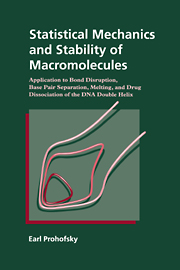 Statistical Mechanics and Stability of Macromolecules
Statistical Mechanics and Stability of Macromolecules Book contents
- Frontmatter
- Contents
- Preface
- 1 Introduction
- 2 Macromolecular stability
- 3 Lattice dynamics
- 4 Effective phonon theory
- 5 Premelting disrupted chemical bonds
- 6 Cooperative melting
- 7 Strained chemical bonds: salt and pressure effects
- 8 Bond disruption and conformation change: B to Z conformation change in DNA
- 9 Hydration effects: structural water
- 10 Helix with daunomycin intercalated: increased helix stability and daunomycin-DNA binding constant
- 11 Nonrepeating DNA
- 12 Cutting and splicing: junctions, inserts, and the replicating fork
- 13 Interaction between a helix and a single attached molecule
- 14 Energy considerations in bond opening
- Appendix 1 Helical lattice dynamics
- Appendix 2 Density matrix and effective phonon theory
- Appendix 3 Green functions
- References
- Index
4 - Effective phonon theory
Published online by Cambridge University Press: 16 September 2009
- Frontmatter
- Contents
- Preface
- 1 Introduction
- 2 Macromolecular stability
- 3 Lattice dynamics
- 4 Effective phonon theory
- 5 Premelting disrupted chemical bonds
- 6 Cooperative melting
- 7 Strained chemical bonds: salt and pressure effects
- 8 Bond disruption and conformation change: B to Z conformation change in DNA
- 9 Hydration effects: structural water
- 10 Helix with daunomycin intercalated: increased helix stability and daunomycin-DNA binding constant
- 11 Nonrepeating DNA
- 12 Cutting and splicing: junctions, inserts, and the replicating fork
- 13 Interaction between a helix and a single attached molecule
- 14 Energy considerations in bond opening
- Appendix 1 Helical lattice dynamics
- Appendix 2 Density matrix and effective phonon theory
- Appendix 3 Green functions
- References
- Index
Summary
Choice of methods
As discussed in earlier chapters, several advantages point to the use of an effective phonon approach to study dynamics in a large nonlinear system such as the DNA double helix. The first advantage is that in the effective phonon formulation unbounded interactions replace bounded interactions and this change allows one to apply statistical mechanical ensemble theory to the system without running into problems associated with infinite thermodynamic integrals. The second advantage is that the selfconsistent phonon approach divides the large nonlinear dynamics problem into two parts, 1) the incorporation of nonlinearities into an effective force constant, and 2) the solution of the large number of degrees of freedom by normal mode means. A third implicit advantage is related to the built in harmonic approximation, i.e. the advantage of not having to solve for the ground state conformation before being able to proceed to the dynamic solutions. All these theoretical and calculational advantages are present in the approach developed.
In addition to the theoretical advantages discussed above there is a very practical reason to formulate the dynamics as an effective phonon problem. Direct experimental observation of the vibrational excitations of double helices by Raman scattering and infrared absorption indicate that they are resonant rather than relaxational. The lines are broad but not so broad as to indicate that one is observing relaxational modes.
- Type
- Chapter
- Information
- Statistical Mechanics and Stability of MacromoleculesApplication to Bond Disruption, Base Pair Separation, Melting, and Drug Dissociation of the DNA Double Helix, pp. 60 - 77Publisher: Cambridge University PressPrint publication year: 1995


